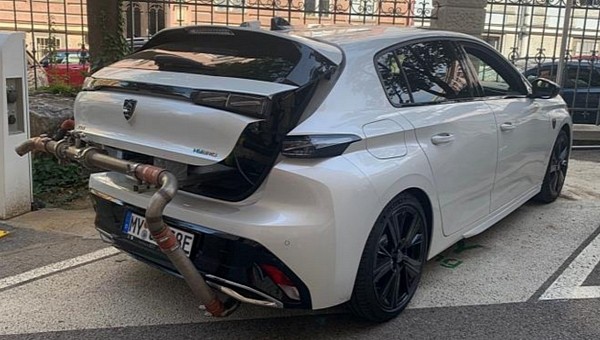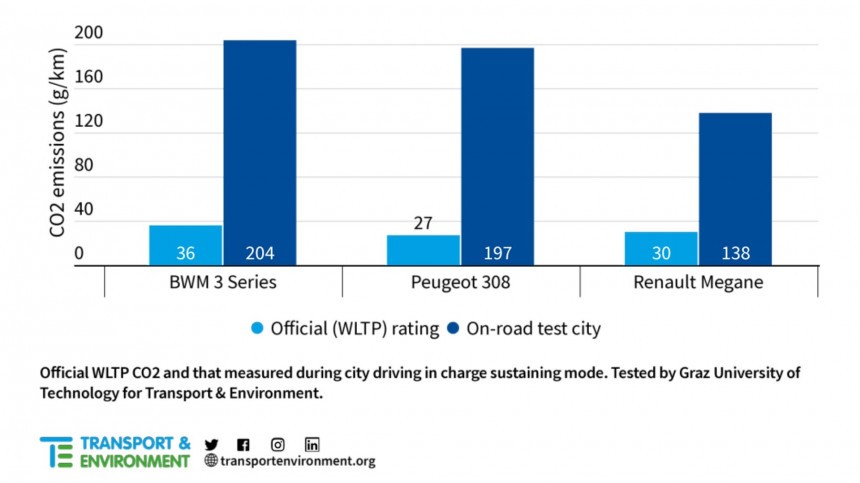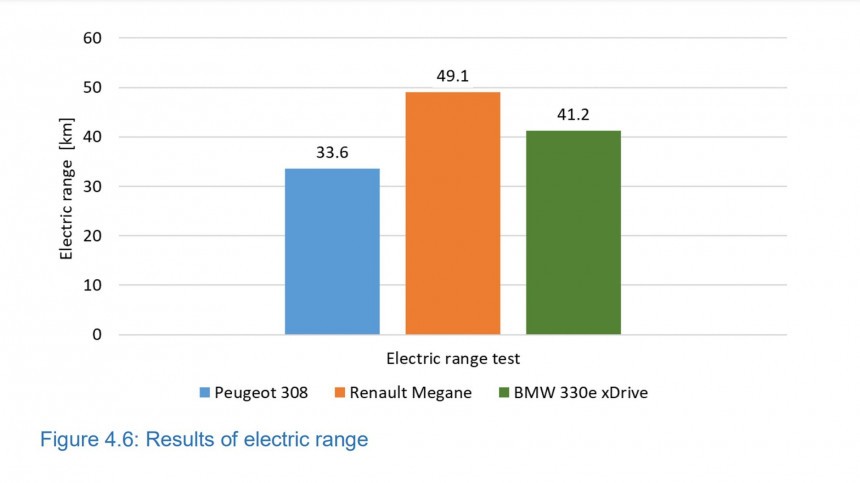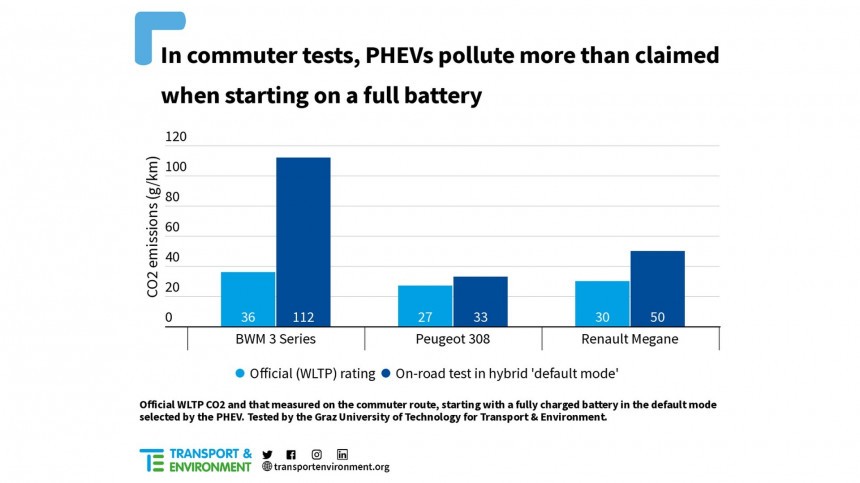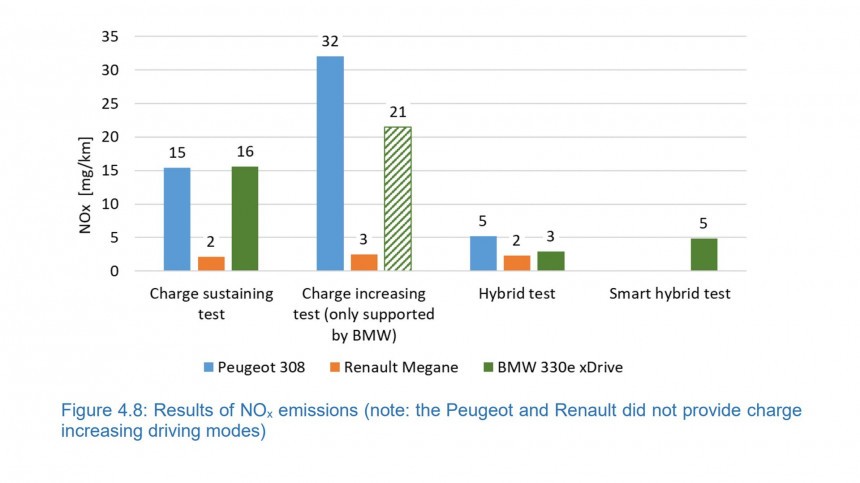In November 2020, Transport & Environment (T&E) analyzed three plug-in hybrids (PHEVs) to determine how much they truly helped prevent pollution and carbon emissions. The results were disappointing: the SUVs were 28% to 12 times dirtier than their automakers claim they are. As that did not help, T&E evaluated three non-SUV PHEVs. It concluded that they are a way of greenwashing.
As I mentioned before, T&E focused on SUVs in its previous tests: BMW X5, Volvo XC60, and Mitsubishi Outlander PHEV. With a fully-charged battery, in EV mode, and optimal conditions, they could emit 28 percent to 89 percent more CO2 than advertised.
The organization did not mention in which conditions that happened, but it was for a distance that T&E did not disclose. That’s because the electric range in these SUVs was enough for only 11 kilometers (6.8 miles) in the worst case and 23 km (14.3 mi) in the best one. When the electric-only range ends, the combustion engines keep the journey going. However, it is a bit more complex than that, as you’ll see a bit later.
In two other scenarios, probably with the same undisclosed distance, the vehicles also performed really poorly. With a discharged battery pack, emissions rise three to eight times more than the official numbers the automakers disclose. If the PHEVs run in battery-charging mode, that skyrockets to three to twelve times more.
At the time, the message was that having a plug-in hybrid SUV did not make much sense, especially if it presented a small battery pack. Even a large one would be penalized by the frontal area and weight of such a vehicle. T&E’s new tests try to demonstrate that the problem is not restricted to SUVs.
The organization selected a BMW 330e xDrive (station wagon), a Peugeot 308 Hybrid 225, and a Renault Mégane E-TECH Plug-in Hybrid 160 (two hatchbacks). In Europe, very few PHEVs are lighter or more aerodynamic than these three. According to the organization, that did not prevent them from being inefficient in their goal of preventing pollution.
The Technical University of Graz (TU Graz) had five tests for the PHEVs, but only the 330e was able to undergo two of them. The BMW station wagon has a geofencing capacity that activates the electric-only drive in the city and also a charge increase mode, which uses the combustion engine to charge the battery pack. That said, the Austrian university could only submit the three PHEVs to the three tests left, which consisted of evaluating the electric range they offered and their emissions when the battery pack is discharged.
To be honest, TU Graz also tried to include the Megane and the 308 in the charge increase test, which went from the Infelld campus up to Ilz and back for a 190.2-km (118.2-mi) route. However, their battery packs finished the evaluation with no charge despite starting it at 50%. In other words, they only lost electrons, invalidating their emission results: the idea was to show how much more emissions they had when charging the battery pack, which did not happen.
The electric-only range tests took two laps in a 32.6-km (20.3-mi) route. The trial ended when the combustion engine in the PHEVs started working. Only the Renault hatchback met the disclosed range: 48 km on the WLTP cycle. It delivered 49.1 km (30.5 mi). Despite claiming the most extensive EV range (63 km or 39.2 mi), the Peugeot 308 returned only 33.6 km (20.9 mi), or 47% less than expected. The BMW did a little better, but also disappointed. Instead of 56 km (34.8 mi), it could run only 41.2 km (25.6 mi) in EV mode. That’s 26% less than its official numbers.
None of these plug-in hybrids is programmed to work 100% of the time in electric mode: it is the driver who has to select it. All three operate in hybrid mode as standard, choosing the most efficient way to move depending on each circumstance. That has a direct impact on the pollution these PHEVs generate.
TU Graz tested them driving from its campus to Ilz, a 55.6 km (34.6 mi) route. Considering it went to Ilz and returned to Graz in the hybrid mode test, make that 111.2 km (69.2 mi). The longer the electric range, the lower the carbon emissions would be, but the way these cars work does not focus on that, which is probably the most telling conclusion the study reaches.
BMW claims the 330e emits only 36 g/km of carbon dioxide (CO2). In the TU Graz hybrid test, it emitted 112 g/km, which is 3.4 times the official number. The 308 and the Megane did much better, even if they were still above their emission claims. The Renault should have delivered 30 g/km of CO2 but ended up with 50 g/km of the gas – 66.7% more than it should have. The Peugeot hatchback was the best one in this evaluation: instead of 27 g/km, it presented 33 g/km, or 22% more. And that has only to do with carbon dioxide emissions.
In the tests in which only the BMW presented valid results, the station wagon emitted 255 g/km when it was trying to recharge while driving and 66 g/km when its geofencing capacity turned EV mode on in city areas. For T&E, that shows these vehicles are a severe greenwashing case and do not deserve to be considered green alternatives. That said, the organization defends that governments should not incentivize their sales.
PHEVs also emit nitrogen oxides (NOx), carbon monoxide, particulates, and several other pollutants, but TU Graz only measured the ones we mentioned. Sadly, we do not have the official numbers of each of these pollutants to compare them with what the Austrian university found. Anyway, it is essential to remember that they should also concern people worried about combustion engines. Carbon dioxide became the major worry due to the urgency to revert climate change.
Although the study revealed some problems with PHEVs, it was used by T&E as evidence that these vehicles are not a viable climate solution. The organization is correct, but not for the reasons it presents or for the data it obtained. The truth is that no vehicle will ever be a viable climate solution. I will discuss this in another text. There are nuances that need to be considered in a deeper conversation.
The organization did not mention in which conditions that happened, but it was for a distance that T&E did not disclose. That’s because the electric range in these SUVs was enough for only 11 kilometers (6.8 miles) in the worst case and 23 km (14.3 mi) in the best one. When the electric-only range ends, the combustion engines keep the journey going. However, it is a bit more complex than that, as you’ll see a bit later.
In two other scenarios, probably with the same undisclosed distance, the vehicles also performed really poorly. With a discharged battery pack, emissions rise three to eight times more than the official numbers the automakers disclose. If the PHEVs run in battery-charging mode, that skyrockets to three to twelve times more.
The organization selected a BMW 330e xDrive (station wagon), a Peugeot 308 Hybrid 225, and a Renault Mégane E-TECH Plug-in Hybrid 160 (two hatchbacks). In Europe, very few PHEVs are lighter or more aerodynamic than these three. According to the organization, that did not prevent them from being inefficient in their goal of preventing pollution.
The Technical University of Graz (TU Graz) had five tests for the PHEVs, but only the 330e was able to undergo two of them. The BMW station wagon has a geofencing capacity that activates the electric-only drive in the city and also a charge increase mode, which uses the combustion engine to charge the battery pack. That said, the Austrian university could only submit the three PHEVs to the three tests left, which consisted of evaluating the electric range they offered and their emissions when the battery pack is discharged.
The electric-only range tests took two laps in a 32.6-km (20.3-mi) route. The trial ended when the combustion engine in the PHEVs started working. Only the Renault hatchback met the disclosed range: 48 km on the WLTP cycle. It delivered 49.1 km (30.5 mi). Despite claiming the most extensive EV range (63 km or 39.2 mi), the Peugeot 308 returned only 33.6 km (20.9 mi), or 47% less than expected. The BMW did a little better, but also disappointed. Instead of 56 km (34.8 mi), it could run only 41.2 km (25.6 mi) in EV mode. That’s 26% less than its official numbers.
TU Graz tested them driving from its campus to Ilz, a 55.6 km (34.6 mi) route. Considering it went to Ilz and returned to Graz in the hybrid mode test, make that 111.2 km (69.2 mi). The longer the electric range, the lower the carbon emissions would be, but the way these cars work does not focus on that, which is probably the most telling conclusion the study reaches.
In the tests in which only the BMW presented valid results, the station wagon emitted 255 g/km when it was trying to recharge while driving and 66 g/km when its geofencing capacity turned EV mode on in city areas. For T&E, that shows these vehicles are a severe greenwashing case and do not deserve to be considered green alternatives. That said, the organization defends that governments should not incentivize their sales.
Although the study revealed some problems with PHEVs, it was used by T&E as evidence that these vehicles are not a viable climate solution. The organization is correct, but not for the reasons it presents or for the data it obtained. The truth is that no vehicle will ever be a viable climate solution. I will discuss this in another text. There are nuances that need to be considered in a deeper conversation.
